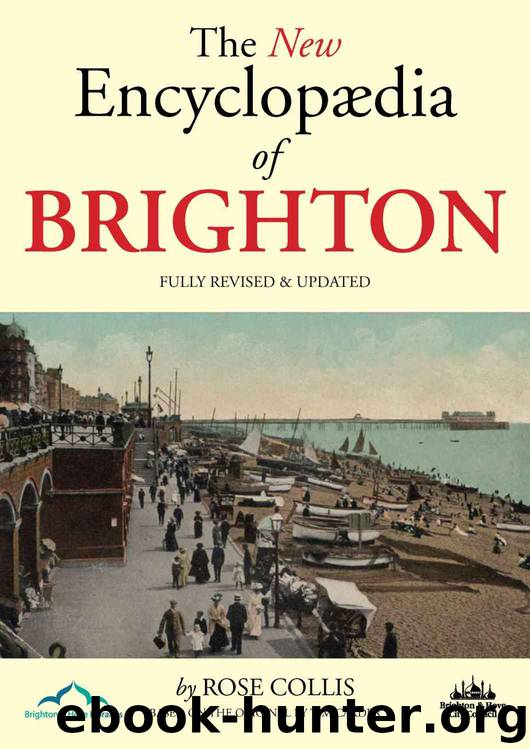The New Encyclopaedia of Brighton by Tim Carder & Rose Collis

Author:Tim Carder & Rose Collis [Carder, Tim]
Language: eng
Format: epub
Publisher: Brighton & Hove City Libraries
Published: 2012-11-26T18:30:00+00:00
MARLBOROUGH HOUSE
This grade I listed building is the oldest remaining house on the Old Steine. It was built in about 1765 for Samuel Shergold of the Castle Inn, who let it to fashionable visitors, and was originally a three-storey, red-brick building with a steeply pitched tiled roof, dormer windows, and a small pedimented classical doorway. In September 1771, the house was bought by the fourth Duke of Marlborough after whom it is named. In 1786, he sold it to William ‘Single Speech’ Hamilton MP, who employed the most prominent architect of the day, Robert Adam, to remodel the house; it is Adam’s only work in Brighton and a plaque has been erected to him. The facade has two slightly projecting bays topped by pediments, two large round-headed windows, and a pedimented fanlight doorway with fluted Doric columns. The restored interior retains some of Adam’s original features, and the principal rooms have good ceilings and fireplaces. The Prince of Wales stayed with Hamilton for three days in April 1789, and in June 1795 stayed there again for nearly three weeks, this time with his (legal) wife, Princess Caroline of Brunswick. Hamilton died the following year, and the house was auctioned for 4,000 guineas. During the 1850s, Marlborough House was the residence of Charles Sabine Augustus Thellusson, Commodore of the Royal Victoria Yacht Club. In 1859, he inherited half the estate of his great-grandfather Peter Thellusson after a long-running court case which led to the Accumulations Act 1800, and inspired Charles Dickens to write a fictional account of the case, Jarndyce v Jarndyce, in Bleak House. In about 1870, the house was purchased by John Beal, the publisher and stationer of East St who used the basement as a store, but he leased the ground floor and upper storeys to the Brighton School Board for use as offices. The school board purchased the property outright in September 1891 for £7,000, and the building remained in use as education offices, first for the school board and then for the county borough council, until the county council took over responsibility for education in 1974. Marlborough House then became the offices of the council’s Tourism and Resort Services Department. In October 1999, the building — then in a state of poor repair — was sold to Eurolink company founder Tony Antoniades. He caused some outrage amongst conservationists when he opened a valet car wash service in the building’s forecourt, saying it was necessary to raise £75,000 towards its restoration (the portico cost £30,000 alone to restore). The work, including restoration of the Robert Adam façade and windows, together with a new roof to the front part of the building, was undertaken by conservation architects Insalls, with advice from Nick Tyson of the Regency Town House project.
Download
This site does not store any files on its server. We only index and link to content provided by other sites. Please contact the content providers to delete copyright contents if any and email us, we'll remove relevant links or contents immediately.
Periodization Training for Sports by Tudor Bompa(7327)
The MacArthur Bible Commentary by John MacArthur(4236)
The Body: A Guide for Occupants by Bill Bryson(3799)
The Sports Rules Book by Human Kinetics(3588)
What It Really Takes to Get Into Ivy League and Other Highly Selective Colleges by Hughes Chuck(3220)
Marijuana Grower's Handbook by Ed Rosenthal(3117)
The Sprouting Book by Ann Wigmore(3052)
Salt, Fat, Acid, Heat: Mastering the Elements of Good Cooking by Nosrat Samin(2658)
The Martian by Andy Weir(2609)
Classic by Mary Berry(2501)
The Bread Bible by Rose Levy Beranbaum(2470)
Harry Potter 4 - Harry Potter and The Goblet of Fire by J.K.Rowling(2416)
The Marketing Plan Handbook: Develop Big-Picture Marketing Plans for Pennies on the Dollar by Robert W. Bly(2413)
Sapiens and Homo Deus by Yuval Noah Harari(2412)
Martha Stewart's Baking Handbook by Martha Stewart(2330)
50 Economics Classics by Tom Butler-Bowdon(2066)
Screenplay: The Foundations of Screenwriting by Syd Field(2056)
The Cambridge Grammar Of The English Language by Rodney Huddleston Geoffrey K. Pullum(2046)
The Plant Paradox by Dr. Steven R. Gundry M.D(2038)
